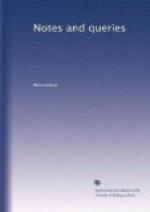To this account of the sepulchre I may add, that one principal part of the solemn rites referred to above consisted in depositing a consecrated wafer or, as at Durham Cathedral, a crucifix within its recess—a symbol of the entombment of our blessed Lord—and removing it with great pomp, accompanied sometimes with a mimetic representation of the visit of the Marys to the tomb, on the morning of Easter Sunday. This is a subject capable of copious illustration, for which, some time since, I collected some materials (which are quite at your service); but, as your space is valuable, I will only remark, that the “Watching the Sepulchre” was probably in imitation of the watch kept by the Roman soldiers round the tomb of Our Lord, and with the view of preserving the host from any casualty.
At Rome, the ceremony is anticipated, the wafer being carried in procession, on the Thursday in Passion Week, from the Sistine to the Paoline Chapel, and brought back again on the Friday; thus missing the whole intention of the rite. Dr. Baggs, in his Ceremonies of Holy Week at Rome, says (p. 65.):—
“When the pope reaches the altar (of the Capella Paolina), the first cardinal deacon receives from his hands the blessed sacrament, and, preceded by torches, carries it to the upper part of the macchina; M. Sagrista places it within the urn commonly called the sepulchre, where it is incensed by the Pope.... M. Sagrista then shuts the sepulchre, and delivers the key to the Card. Penitentiary, who is to officiate on the following day.”
E.V.
* * * * *
POEM BY SIR EDWARD DYER.
Dr. Rimbault’s 4th Qu. (No. 19. p. 302.).—“My mind to me a kingdom is” will be found to be of much earlier date than Nicholas Breton. Percy partly printed it from William Byrds’s Psalmes, Sonets, and Songs of Sadnes (no date, but 1588 according to Ames), with some additions and improvements (?) from a B.L. copy in the Pepysian collection. I have met with it in some early poetical miscellany—perhaps Tottel, or England’s Helicon—but cannot just now refer to either.
The following copy is from a cotemporary MS. containing many of the poems of Sir Edward Dyer, Edward Earl of Oxford, and their cotemporaries, several of which have never been published. The collection appears to have been made by Robert Mills, of Cambridge. Dr. Rimbault will, no doubt, be glad to compare this text with Breton’s. It is, at least, much more genuine than the composite one given by Bishop Percy.
“My mynde to me a kyngdome is,
Suche preasente joyes therin
I fynde,
That it excells all other blisse,
That earth affordes or growes
by kynde;
Thoughe muche I wante which moste would
have,
Yet still my mynde forbiddes to crave.
“No princely pompe, no wealthy store,
No force to winne the victorye,
No wilye witt to salve a sore,
No shape to feade a loving
eye;
To none of these I yielde as thrall,
For why? my mynde dothe serve for all.




